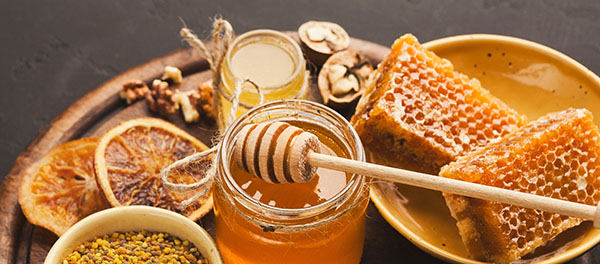See clearly with this sweet cure: Study shows honey can help treat dry eye disease
09/27/2023 / By Evangelyn Rodriguez

Honey is known for its many health-supporting properties and versatile uses. Considered a healthy alternative to sugar and artificial sweeteners, honey is a favorite among health enthusiasts because of its cardiometabolic benefits. Studies show that unprocessed raw honey, in particular, can help lower fasting blood glucose, total cholesterol, low-density lipoprotein cholesterol and fasting blood triglycerides when used as a substitute for regular sweeteners.
Historically, honey has been used by various cultures as a natural remedy for a variety of ailments, such as insomnia, skin issues (e.g. wounds and burns), digestive problems, cardiac pain and palpitation, gout, cough, sore throat, diarrhea and infections. Today, honey’s antibacterial and wound healing properties are utilized even in clinical practice, with hospitals using sterile honey-impregnated wound dressings to treat burn and surgical wounds as well as infected, malodorous wounds.
But aside from these applications, many may not be aware that honey is also traditionally used to treat eye-related issues. In fact, in Ayurvedic medicine, applying honey to the eyes daily is believed to help improve eyesight and treat eye irritation or infection. An animal study published in the journal Molecular Vision also found that an antioxidant in honey called chrysin can prevent cataract formation by protecting against oxidative damage and inhibiting the death of lens cells.
Because of honey’s proven effectiveness in treating different eye conditions, some modern eye medications now include honey as an active ingredient. One common eye condition for which honey-based formulations appear to work extremely well is dry eye disease (DED). According to recent studies, even just supplementing with honey or royal jelly, another honey bee product, can help relieve the symptoms of DED.
What is dry eye disease?
Dry eye disease occurs when the eyes don’t produce enough tears to stay wet or when tears don’t work as intended. This common eye condition affects millions of Americans and can be caused by a variety of things, such as poor blinking habits especially while reading or staring at a computer screen, dry indoor environments, hormonal changes in postmenopausal or pregnant women, and wearing contact lenses. Certain prescriptions, such as antihistamines, heart medications, diuretics and birth control pills, can also cause DED.
According to research, tear film hyperosmolarity and oxidative stress are heavily involved in the development of DED. Hyperosmolarity, which is characterized by high salt concentrations, directly causes damage to cells in the cornea, which starts the cascade of events that leads to DED. Oxidative stress and tear film hyperosmolarity both trigger inflammation in the ocular surface, which causes the death of many eye cells, including the goblet cells that produce mucin. Mucin is a lubricating and eye-clearing agent that also acts as a protective barrier for the cornea. DED occurs as a result of the loss of eye mucin.
Common symptoms of DED include:
- A scratchy feeling, like there’s something in your eye
- Stinging or burning sensation in your eye
- Red eyes
- Sensitivity to light
- Blurry vision
Current treatment options for DED include artificial tears (eye drops), topical steroids or cyclosporine, lacrimal punctal occlusion, lifestyle changes and oral omega-3 fatty acid supplementation. Although artificial tears help improve symptoms of DED, they do not address the inflammation underlying DED. Topical steroids, in comparison, have anti-inflammatory properties, and their efficacy in improving DED symptoms is well-established. However, their long-term use is not recommended as they can cause serious side effects, such as the development of cataracts or secondary glaucoma.
Other conventional anti-inflammatory treatment strategies for people with DED include the use of an immunosuppressive drug like cyclosporine or the anti-inflammatory eye drop, lifitegrast. But like many other pharmaceutical medications, both are known to cause unpleasant side effects.
Honey can relieve symptoms of DED
Honey has been used to treat ophthalmic diseases for thousands of years. Honey is composed of carbohydrates, water, organic acids, proteins and amino acids, vitamins and minerals, enzymes, flavonoids and antimicrobial components, such as hydrogen peroxide and antimicrobial peptides. Antioxidant flavonoids, such as chrysin, pinocembrin, quercetin and phenolic acids, are believed to be responsible for honey’s antibacterial, antioxidant, anti-inflammatory, immune-modulating and pain-relieving properties.
More than 300 varieties of honey are known to exist. Manuka honey, arguably the most popular and potent of all honey types, contains a proprietary mix of honey from the Australian and New Zealand Leptospermum (manuka) species. Manuka honey’s antibacterial activity is said to be unrivaled, and studies have proven that it is highly effective even against methicillin-resistant Staphylococcus aureus (MRSA) and Pseudomonas aeruginosa. (Related: HONEY: Is this ancient medicinal food the key to fighting deadly drug-resistant infections?)
Numerous studies have also reported the efficacy of honey in treating a wide range of ophthalmic diseases, such as chemical and thermal burns, corneal bacterial ulcers, postoperative corneal edema, bullous keratopathy, neurotrophic keratitis, vernal keratoconjunctivitis and catarrhal keratoconjunctivitis. This benefit has been attributed to honey’s ability to stimulate immune cells and promote re-epithelialization (the formation of new epithelium) and angiogenesis (the formation of new blood vessels), which are both important for tissue repair and regeneration.
In a study published in the journal Pharmaceuticals, European researchers investigated the effectiveness of honey-based treatment strategies (i.e., honey supplementation and the use of eye drops containing honey) in relieving symptoms of DED. After analyzing data from clinical trials that involved a total of 323 patients, the researchers found that honey-based treatments significantly increased tear breakup time, or the time it takes for a dry spot to appear on the cornea after a complete blink. A short tear breakup time (<5 seconds) is a sign of poor tear film and inadequate or poor-quality tears.
Honey-based treatments also increased tear production in DED patients, as shown through the Schirmer I test. This test is used to determine whether the eyes generate enough tears to keep them moist. At the same time, topical and oral administration of honey reduced the patients’ Ocular Surface Disease Index scores, which are reflective of DED symptoms and their impact on everyday vision-related functions. Honey also helped reduce damage to the cornea caused by inflammation and tear film hyperosmolarity, as assessed by corneal staining. None of the patients reported any severe adverse effects.
Taken together, these findings suggest that topical application or oral supplementation of honey can effectively relieve symptoms of DED without causing unpleasant side effects. Honey supplements and eyedrops that contain honey are viable treatment options for DED and should be further investigated for their therapeutic potential. (Related: Study: Goji berries boost eye health, help prevent vision problems, study concludes.)
If you’re wondering which among the hundreds of honey varieties can best help with DED, look no further than manuka honey. Thanks to its potent anti-inflammatory and antibacterial properties as well as its ability to promote tissue regeneration, manuka honey can help treat a variety of eye conditions, including DED. Research has also found that manuka honey can stabilize the surface of the eye by lowering its pH and reducing bacterial overgrowth and inflammation.
In a study published in the British Journal of Ophthalmology, researchers looked at the effects of an eye drop containing manuka honey on tear film properties and found that the eye drop greatly reduced the rate of tear evaporation in people with DED. The honey-based eye drop also reduced Ocular Surface Disease Index scores by a significant margin and increased tear film breakup time after 28 days of daily treatment, providing substantial relief from DED.
Honey is an excellent superfood and a potent natural remedy for various ailments. Learn more about honey and other amazing superfoods at Food.news.
Watch this video to learn about how honey can help you sleep better at night.
This video is from the Natural Cures channel on Brighteon.com.
More related stories:
Honey: The ultimate survival food that doesn’t expire.
Honey is medicine: 4 Scientifically proven perks to using Nature’s sweetener.
Honey can serve as a natural treatment for people with bronchial asthma.
More children are now suffering from eye disease that commonly affects older adults.
Carrot carotenoids found to enhance and protect eye health.
Sources include:
OxfordHealth.NHS.uk [PDF]
Submit a correction >>
Tagged Under:
This article may contain statements that reflect the opinion of the author
RECENT NEWS & ARTICLES
COPYRIGHT © 2017 SUPER FOODS NEWS




















